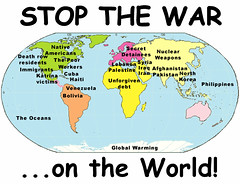Tuesday, April 21, 2009
The uncounted Iraqi dead
I've written many times about the underreporting of the deaths in Iraq caused by the U.S. invasion. The media will report the number "300,000 dead" in Darfur without blinking an eye, even though that number has far less scientific basis than the figure of one million dead in Iraq; the latter is, for all intents and purposes, never reported, and on the rare occasions (none recent) when it was reported, it was always with qualifiers like "contested" or "controversial."
Instead, the media reports as gospel the 99,000 figure from Iraq Body Count, a number which even IBC admits is an absolute minimum, not a "best estimate." But there are, again as I and others have written, numerous reasons why that number is far from accurate. To begin with, IBC counts only civilians. But every Iraqi soldier killed defending his country from an illegal foreign occupation, and every Iraqi resistance fighter killed resisting an illegal foreign occupation were killed with no more justification, legal or moral, than any "civilian."
And then we have the very definition of "civilian." To the U.S. military, as countless incidents in Iraq and Afghanistan (and elsewhere) have demonstrated, every dead person is assumed to be an "insurgent" or a "terrorist" until proven otherwise. And that's important, because in the first years of the war, when reporters were under self-imposed house arrest in their Baghdad offices, the U.S. military was the primary and in most cases the only source of information. So if the military reported killing 50 insurgents in an air strike, who was going to prove otherwise?
And then, of course, there is the IBC methodology. They've changed now, as the situation has changed, but during the intense period of the fighting and dying, their standard was two corroborating reports in the English-language press. This "methodology" not only falls victim to the inability to report just mentioned, but also to the "multiple victim" problem. When 20 people are killed in one attack, and 15 in another, is it news that in another town, one or two people were killed?
Or consider this: in the U.S., in a typical year, more than 10,000 people are killed by guns, knives, etc. How many of those deaths were reported anywhere other than the local paper, if that? How many were carried on the AP wires, for example? Industrious journalism student with access to Lexis/Nexis, get cracking and answer that question for us, will you? Because I'm guessing the number is a small fraction of that 10,000.
And finally, there's yet another group (and probably more) which is deliberately excluded - people dying from inadequate health care in a system both destroyed by a decade of sanctions and by the "shock and awe" of the invasion and occupation. Which is, as it turns out, what prompts me to revisit this subject. The San Jose Mercury News carried an article about the handful of Iraqi refugees who have been allowed to resettle in the U.S. In typical "brain drain" fashion, most of those with enough money, smarts, and/or pull to get into the U.S. are the doctors, engineers, lawyers, etc.; in not-so-typical fashion, they unfortunately arrived at a time when jobs are few and far between, even for the well-educated. But what caught my eye wasn't that subject at all, but the story of one of the profiled refugees:
Gholam can't stop thinking and dreaming of the life she once had. "I was completely spoiled as a child and had the best mother in the world," she said. "Then I got married and worked as a math and science teacher. I loved my husband. We had a beautiful house and a beautiful daughter named Iraq. No one had a happier life than me."There are two deaths in that story. The mother died from a burst appendix because she couldn't get to a hospital. Is her blood on the hands of George Bush, Dick Cheney, and the Congress who authorized the invasion of Iraq? You bet it is. Is her name on the Iraq Body Count list? You bet it isn't. Then there's the death of the daughter. The article doesn't say what town Gholam was living in, although we can assume it was either Al-Kut or a town close by. But Iraq Body Count lists just four "incidents" for March 31. In and of itself, that should be a tipoff as to the inaccuracy of their database. The invasion began just 11 days before that; is it really credible that the U.S. only carried out four attacks that day which took civilian lives? The four listed were "21 killed by air strikes in Bartalha, NE of Mosul, 15 by air strike in Haidariya, 6 by air strikes in Al-Amin, Baghdad, and 11 by machine-gun fire at a passenger car at an Army checkpoint near Najaf." None of those are anywhere near Al-Kut, or in eastern Iraq at all, so it appears that Gholam's daughter, and anyone else killed in that same attack, are also absent from the database.
Then came shock and awe.
As American bombs began raining on her town near Al-Kut in eastern Iraq after the war began, her family tried to get away by moving to the house of some friends. But the bombs seemed to follow them.
Gholam was too afraid to take her mom to the hospital when she had an appendicitis attack. The appendix burst and she died.
Then, on the afternoon of March 31, 2003, she saw a U.S. plane buzzing the neighborhood. Terrified, she prayed for it to go away. Moments later, a bomb dropped on the house.
Gholam was in a coma for four months, waking up in a hospital in Vienna. She was mostly paralyzed on her left side and was deaf in one ear.
It took several weeks before her husband had the heart to tell her that their daughter had been killed in the air assault.
Barack Obama, talking about prosecuting torturers and torture-enablers, says he "doesn't want to look back." I'm guessing that the families of a million dead Iraqis very much want to look back, and not only at the Bushes and Cheneys and Rumsfelds who were the principal instigators of the war that resulted in those deaths, but at the Pelosis and Obamas who voted year after year to keep the killing going (and are still doing so as we speak).



